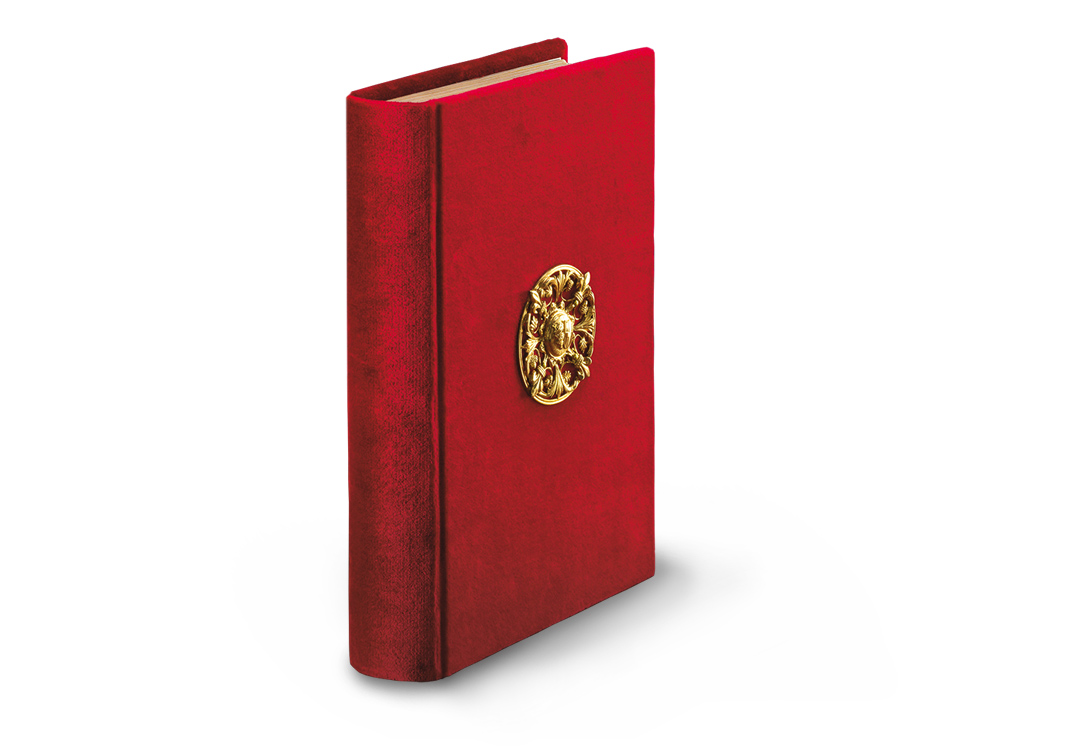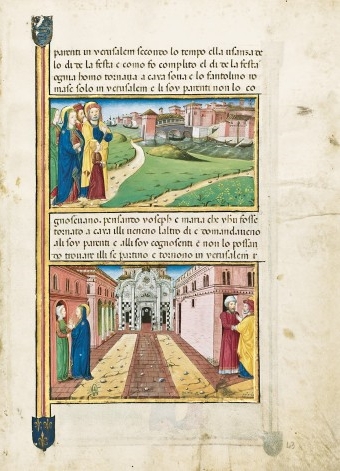The Sforza Legendarium
Bible Stories in the Radiant Colours of the Renaissance
In radiant colours and sparkling gold the Sforza Legendarium presents a subtly composed pictorial narrative of Christ’s earthly family. Admire this wonderful masterpiece made by Cristoforo de Predis, one of the greatest book illuminators of his time! Galeazzo Maria Sforza, Duke of Milan, who delighted in the ostentatious display of his wealth, commissioned this manuscript, and it is one of the most beautiful books of the Italian Renaissance. An overwhelming stream of gorgeous images takes the viewer to the cities and landscapes of 15th century Lombardy. Marvel at the meticulous attention the artist gave to designing his figures, making them come alive!
Legendarium der Sforza
The Sforza Legendarium: The Manuscript Legendarium
A Renaissance Masterpiece
Providing an incredible wealth of masterly pictures, the Sforza Legendarium illustrates the legends about Christ and his earthly family with the utmost artistry.
Various elements of Renaissance art are reflected in the skilful architectural designs, the structures drawn in central perspective, the play of light and shade – as well as the figures’ expressive facial features and their gestures. The ingenious book illuminator repeatedly divided the text passages into several separate scenes and even allotted individual miniatures to events preceding or following the main scene. Thus, he created a unique choreography of the biblical narrative.
Virtuosity in Book Illumination
The Sforza Legendarium was created by the highly accomplished book illuminator Cristoforo de Predis who in 1471 began to work as a miniaturist at the Sforza court in Milan. He was born deaf and dumb, a handicap which might have raised his powers of observation and his awareness of colour. His miniatures are particularly noteworthy not only for the many details in them which reflect the everyday life of the time, but also for the highly animated gestures of the figures. His art is not abstract, but rather the result of careful observation. Being an avid chronicler, he was acutely aware of his surroundings: natural phenomena, his city, everyday life and the emotions of his fellow men.
Made for the Duke of Milan
Galeazzo Maria Sforza, Duke of Milan, was a Renaissance prince with a predilection for pomp, but also a generous patron of art and music. His court was one of the most magnificent in Italy in the 15th century. In 1476 he commissioned the book illuminator Cristoforo de Predis to illustrate the Legendarium which was intended as a practical aid to devotion. Since the artist employed strong colours and shining gold and silver, the luxurious illumination was probably very much to the duke’s taste. Moreover, by looking at the miniatures, he could recognise many of the landscapes and buildings of Lombardy. The texts for the Sforza Legendarium were presumably assembled by Galeazzo’s court chaplain.
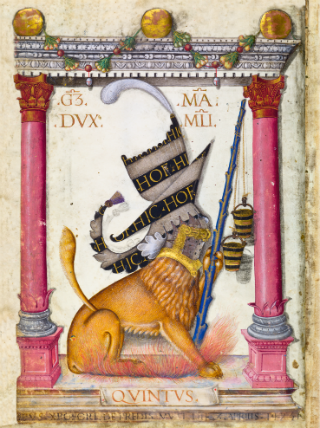
Legendarium der Sforza
Under the Magnifying Glass: Bible Stories in a Contemporary Setting
In the miniatures by Cristoforo de Predis, the stories about Joachim and Anna, the Virgin Mary, Christ and John the Baptist are set off against townscapes and architectural structures unmistakably reflecting Lombard Renaissance architecture. It is a pleasure to discover historical details in the buildings depicted and to identify their actual models. Several distinctive buildings can be clearly recognized. Likewise, equivalents in quattrocento architecture can be found for the representations of coloured interiors adorned with friezes. The contemporary viewer, first and foremost the duke, would thus more easily identify with the pictures he was looking at, and ultimately with the pictorial narrative of the history of salvation.
On fol. 43r both miniatures show a number of reminiscences of famous buildings in Milan and the surrounding area. In a group of pilgrims Mary, Joseph and the 12-year-old Jesus are on their way to Jerusalem for the Feast of Passover. Jerusalem is depicted as a Lombard city. A noteworthy feature is the covered bridge, modelled on a bridge in Pavia. It leads up to a fortress recalling the Castello di Porta Giovia in Milan.
On the return journey Mary and Joseph discover that Jesus is not among the travellers. They return to the Temple in Jerusalem to search for him. The distinctive two-coloured façade in the centre is taken from the old cathedral of Milan.
Legendarium der Sforza
The Sforza Legendarium: The Edition
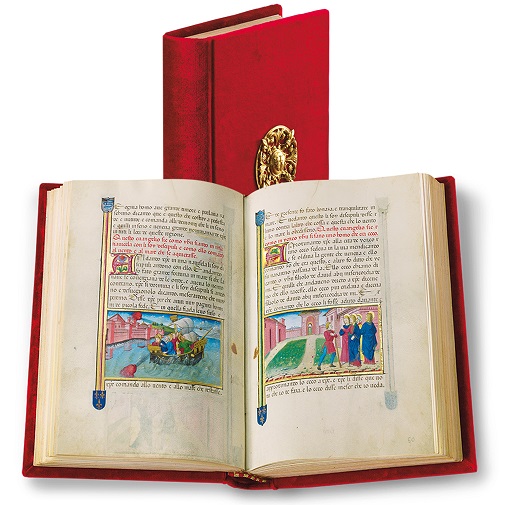
The Manuscript and the Facsimile at a Glance
The Sforza Legendarium; is a true masterpiece, both as regards the original and as a facsimile. The Legendarium creates a deep impression not only by virtue of the wealth of its images but also by means of the superb quality of its miniatures, the gorgeous colours and the choreographed pictorial sequences.
Manuscript: Turin, Biblioteca Reale, Ms. Varia 124
Date of Origin: 1476
Place of Origin: Milan
Dimensions: c. 26.4 x 18.2 cm
Extent: 316 pages (158 leaves)
Artist: Cristoforo de Predis
Patron: Galeazzo Maria Sforza, Duke of Milan/span>
Illumination: 324 colourful miniatures, 107 three-line decorated initials on a gold ground, heraldry in gold and silver on almost all pages
Binding: red velvet with a decorated finely tooled medallion
Commentary Volume for the Facsimile Edition by Pier Luigi Mulas / Luisa Giordano / Giovanni Saccani
The facsimile edition of the Sforza Legendarium is published by Franco Cosimo Panini, Modena. This unique edition is limited to 750 copies. Only 99 copies have been reserved exclusively for the German-speaking clients of Quaternio Editions Lucerne.
This facsimile edition is unfortunately sold out.
Legendarium der Sforza
Enjoy Viewing 10 Sample Pages:
A Glance at the Facsimile
The section from the Sforza Legendarium reproduced here consists of fols. 41r–45v.
In a tightly packed sequence, the miniatures inserted into the text pages illustrate the events in the history of salvation, ranging from the Adoration of the new-born Christ Child by the Magi to the Baptism of Christ in the Jordan by John the Baptist.
Sparkling gold and saturated colours radiate from the miniatures framed in gold. The top and the bottom of each page are decorated with two coats of arms connected by a wide gold band.
Legendarium der Sforza
The Facsimile Folder for the Edition
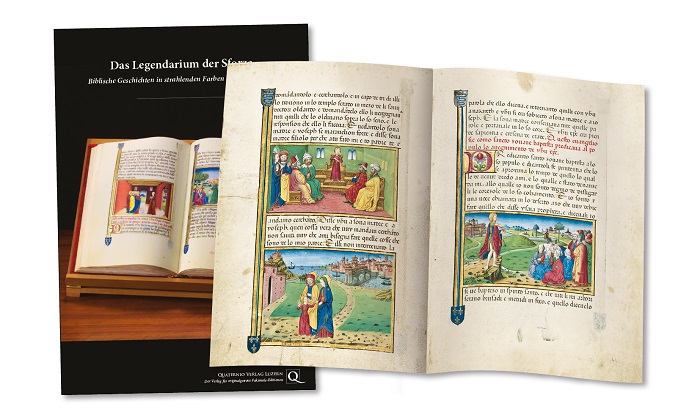
Gain a detailed insight into the splendid Sforza Legendarium by looking at the documentation folder published on the occasion of the facsimile edition!
The linen-bound folder contains a double-leaf of the facsimile depicting events from the life of Christ in six miniatures. These examples allow you to appreciate the miniaturist’s skill at playing with the effects of light and shade, and at drawing architectural structures in central perspective. Discover further details in the notes that explain the elaborate illuminations. In a richly illustrated 16-page brochure, learn more about the art of book illumination in the Renaissance.
Legendarium der Sforza
Order facsimile folder
Click here to go to the online shop (German only) where you can order the facsimile folder for the Sforza Legendarium edition. Or send us an email to info@quaternio.ch.
Request brochure
This edition is unfortunately sold out. We would be glad to provide you with information regarding our other facsimile editions. Click here to order some brochures.





